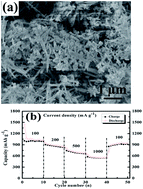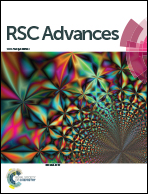Co-pyrolysis synthesis of Fe3BO6 nanorods as high performance anodes for lithium-ion batteries†
Abstract
The high capacity, negligible toxicity, environmentally benign nature and abundant reserves (low cost of elements contained) of the Fe3BO6 nanomaterial enable it to be a highly promising anode material for lithium-ion batteries. In this study, Fe3BO6 nanorods encapsulated in graphite (defined as “Fe3BO6@C”) core–shell like composites have been produced in situ firstly via a co-pyrolysis approach in a stainless-steel autoclave. After subsequent calcinations, Fe3BO6 nanorods with diameters in the range of 20–50 nm were obtained with high yield, which display a first discharge capacity of 1192 mA h g−1 (with a coulombic efficiency of 70%). It is found that at the current density of 100 mA g−1, the specific capacity of the Fe3BO6 nanorods can remain at 873.2 mA h g−1 after 100 cycles; it is worth noting that their specific capacity can still remain at 710 mA h g−1 even if the current density was set at 1000 mA g−1, indicating the excellent cycle stability and promising applications of the as-obtained Fe3BO6 nanorods utilized as anode material at high power field.


 Please wait while we load your content...
Please wait while we load your content...